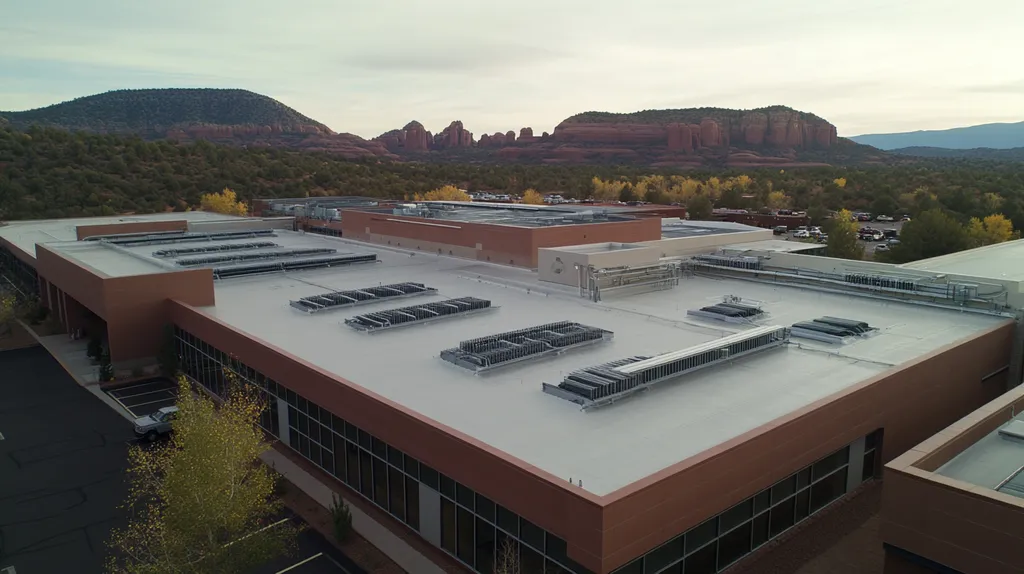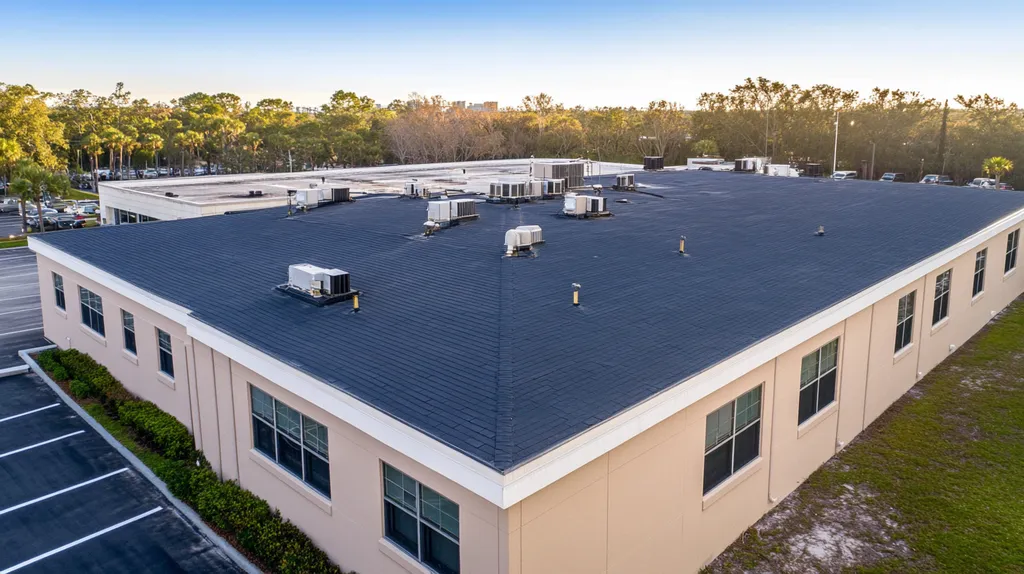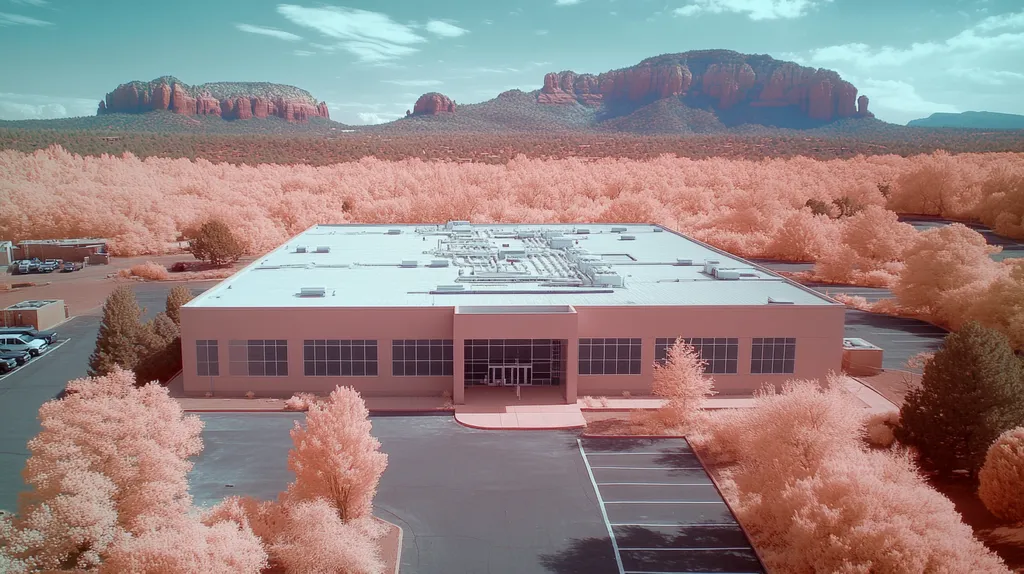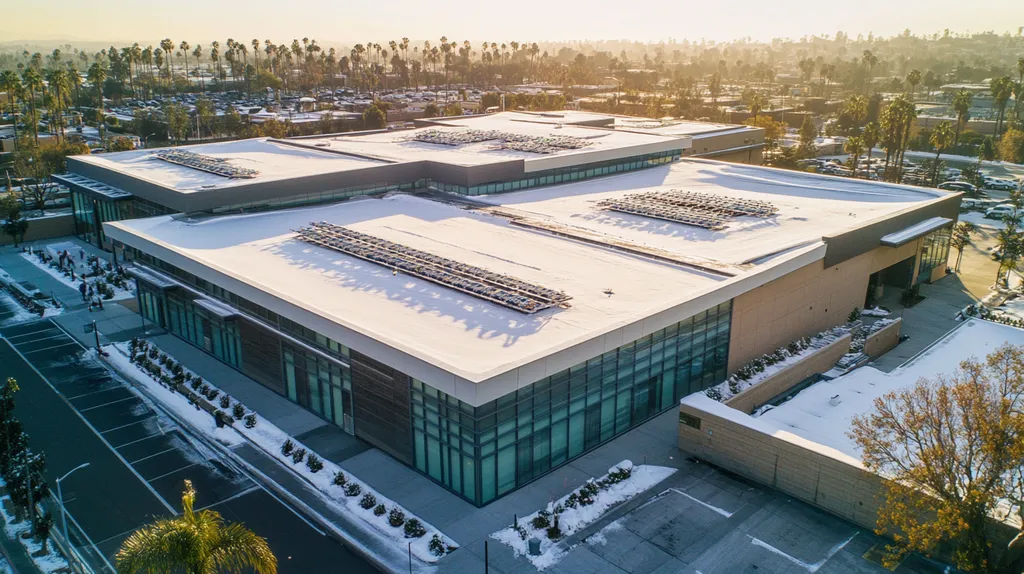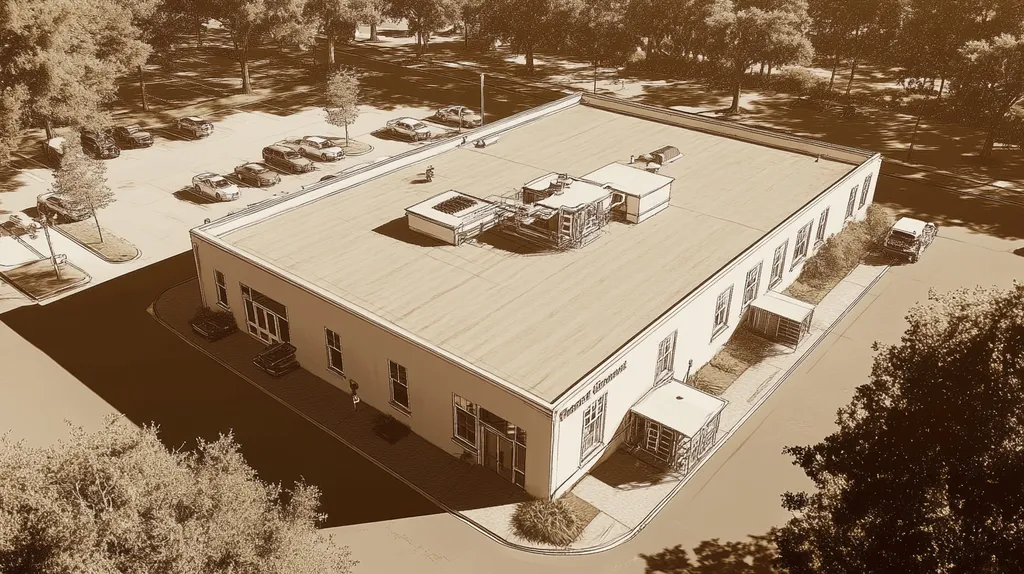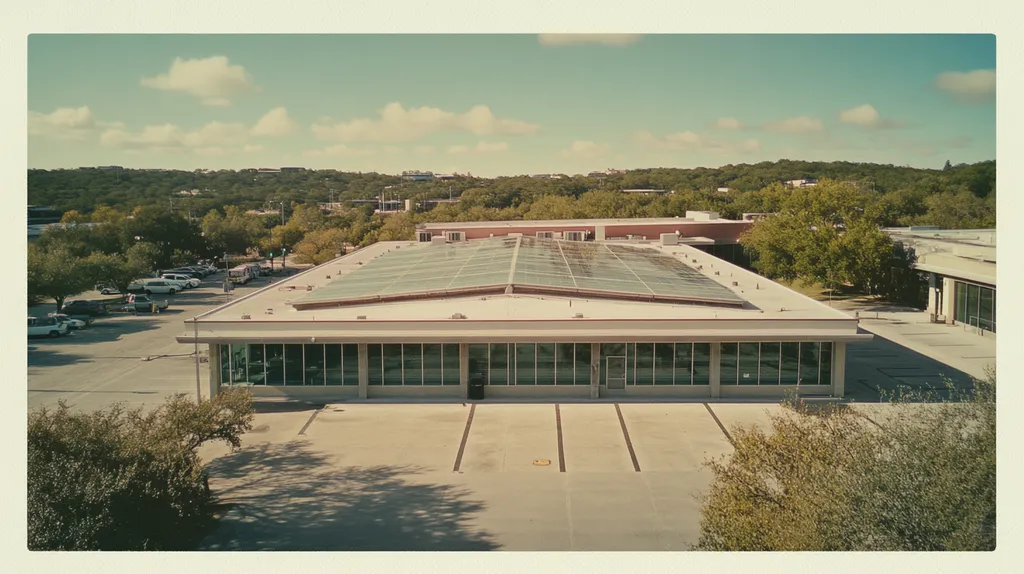Commercial roofing materials contribute up to 30% of a building’s total carbon footprint, yet many property owners continue selecting options that accelerate emissions rather than reduce them.
With buildings accounting for nearly 40% of global carbon emissions, the stakes around roofing material choices have never been higher.
This comprehensive guide examines how performance factors, financial considerations, compliance requirements, risk management strategies, operational procedures and long-term planning can help property professionals make roofing decisions that benefit both the environment and their bottom line.
SECTION 1: PERFORMANCE FACTORS
The selection of roofing materials in commercial buildings plays a vital role in shaping carbon emissions. It’s crucial for property owners to recognize that roofs can account for up to 20% of a building’s total energy use. By prioritizing energy-efficient materials, stakeholders can not only save on operational costs but also significantly curb their carbon footprint. Understanding the performance attributes of roofing materials is essential for making choices that support sustainability goals.
Energy Efficiency Metrics
Energy efficiency stands as a key factor in evaluating roofing materials. Reflective surfaces can significantly lower cooling demands, reducing reliance on energy-intensive air conditioning systems. For example, cool roofs can decrease surface temperatures by as much as 30 degrees Fahrenheit, leading to lower energy bills and diminished greenhouse gas emissions.
The energy efficiency of roofing materials is often assessed through their solar reflectance index (SRI). Higher SRI values indicate superior reflective qualities that help combat the urban heat island effect—a growing issue as cities expand. This makes the implementation of reflective roofing solutions increasingly important.
When choosing roof materials, property owners should also factor in their local climate. Reflective roofing may be advantageous in warmer areas, while good insulation becomes critical in the colder regions. Each climate exhibits unique requirements that influence energy efficiency, making informed roofing decisions essential for effective performance.
Beyond the roof, energy efficiency is part of a broader system that includes insulation, external shading, and HVAC systems. An integrated approach can yield substantial reductions in carbon emissions.
Key Action Items
Insulation and Thermal Performance
Insulation is a critical factor in roofing performance, influencing energy usage and indoor comfort levels. Effective insulation minimizes heat transfer, thereby reducing heating and cooling requirements. For instance, foam insulation boards provide excellent thermal resistance along with moisture control, making them suitable for a variety of commercial roofs.
The thermal capabilities of roofing materials substantially affect a building’s overall efficiency. A well-insulated roof not only restricts heat loss in winter but also retains cool air during summer heat, promoting considerable energy savings and lowering carbon emissions across time.
With building codes increasingly focusing on insulation standards, property managers who meet or exceed these guidelines contribute to both compliance and corporate sustainability objectives. This proactive stance on thermal performance can distinguish a property in a competitive landscape.
Ultimately, prioritizing high-quality insulation materials serves to enhance a building’s durability and efficiency. Property professionals must focus on insulation when selecting roofing materials to ensure optimal performance.
Key Action Items
Durability and Lifespan
The durability and lifespan of roofing materials are pivotal when considering their environmental impact. Materials with shorter lifespans necessitate frequent replacements, resulting in increased waste and resource use. Conversely, high-durability options can last over 30 years, minimizing the need for regular renovations.
Examples such as metal and single-ply membranes exhibit excellent longevity, capable of withstanding harsh weather conditions and significantly prolonging service life. This resilience not only reduces long-term material costs but also lessens the carbon emissions linked to fabricating and shipping new roofs.
Choosing durable materials bolsters climate resilience, as properties equipped with lasting roofs can better withstand extreme weather. This fortitude is particularly important in storm-prone areas, reinforcing the case for durable roofing solutions.
Advancements in material technology now offer sustainable choices that combine both durability and minimized environmental impact. Selecting recycled or recyclable materials can enhance a roof’s sustainability profile while ensuring top performance throughout its lifespan.
Key Action Items
SECTION 2: FINANCIAL CONSIDERATIONS
The choice of commercial roofing materials has serious financial implications that extend well beyond the initial price tag. As property owners face increased pressure to prioritize sustainability and energy efficiency, these decisions significantly influence overall costs and operational performance. With buildings contributing nearly 39% of global carbon emissions—and roofs being a crucial element—understanding the financial landscape, which includes initial investments, long-term savings, and maintenance costs, is essential for making informed choices that benefit both the environment and a property’s financial performance.
Initial Investment and Embodied Carbon
When selecting roofing materials, the initial investment can have lasting consequences for sustainability. While some options may seem more affordable upfront, they often come with a higher embodied carbon—representing the total carbon footprint from manufacturing and installation. For example, while traditional asphalt shingles may initially cost less, their long-term environmental impact can be significant compared to metal roofing alternatives.
Choosing greener materials, such as those with recycled content or energy-efficient properties, can result in a higher initial cost but often lead to reduced carbon emissions and potential financial incentives. Facility managers increasingly seek options that balance upfront expenses against future operational and environmental benefits.
Moreover, choosing durable roofing materials can lower replacement frequencies, decreasing long-term carbon emissions. This approach underscores the significance of weighing both immediate and future costs when evaluating roofing materials.
Key Action Items
Long-Term Energy Savings
Long-term energy savings are a critical factor in determining the overall financial impact of roofing materials. Studies show that energy-efficient roofs can cut cooling costs by up to 20% in warmer regions. Reflective roofing solutions, for instance, significantly reduce heat absorption, leading to lower energy consumption.
Property owners who invest in energy-efficient roofing can expect substantial savings throughout the life of the roof. Over time, these energy savings can often outweigh the initial investment associated with more sustainable materials. Implementing efficient technologies also enhances a property’s appeal to both prospective tenants and buyers.
Incorporating smart roofing innovations, like green roofs or energy-generating solar systems, offers dual advantages, minimizing energy usage while creating revenue streams. This holistic assessment of roofing materials aligns financial objectives with ecological responsibility, reinforcing the case for investment in sustainable solutions.
Key Action Items
Maintenance and Replacement Costs
Maintenance and replacement costs are often underestimated in the roofing decision-making process. While cheaper materials may save money upfront, they frequently result in increased repair expenses and earlier replacements, ultimately inflating total costs. For instance, roofs made from lower-quality materials typically incur higher maintenance and labor costs.
In contrast, investing in high-quality, durable roofing materials can lower ongoing maintenance needs. Many premium materials come with extensive warranties and longer lifespans, often translating into reduced lifetime expenses. This consideration is vital, as efficient maintenance also contributes to lowering the structure’s carbon footprint.
Proactive maintenance strategies can detect issues early, preserving the roof’s integrity and enhancing the building’s overall value. Regular inspections and timely repairs aid property managers in extending their roofs’ lifespans while improving energy efficiency.
Choosing materials that require minimal upkeep can result in considerable long-term savings. Factoring maintenance and replacement costs into roofing evaluations provides a comprehensive framework that emphasizes durability and sustainability within financial forecasts.
Key Action Items
SECTION 3: COMPLIANCE REQUIREMENTS
With the pressing realities of climate change, commercial properties are under increasing scrutiny to comply with regulations aimed at reducing carbon emissions. Building owners and facility managers must navigate a complex web of codes and certifications, as failure to comply could lead to hefty fines and reputational damage. Staying informed about these evolving compliance requirements not only protects investments but also enhances sustainability efforts. This section delves into the building codes, certification programs, and environmental regulations that are crucial in making informed roofing material choices.
Building Codes and Standards
Building codes provide mandatory guidelines that outline the materials and construction methods suitable for commercial roofs. These standards are essential for ensuring safety, durability, and environmental accountability. Innovative materials, such as reflective membranes, can help properties meet local energy codes by reducing heat absorption and lowering energy consumption.
In many areas, building codes include specific energy efficiency ratings, encouraging property owners to reflect on how their roofing selections align with these standards. For instance, incorporating energy-efficient materials is a critical step toward compliance with the International Energy Conservation Code (IECC).
Non-compliance with these building codes can trigger fines and necessitate costly rework, driving up overall project costs. Therefore, staying updated on building regulations offers significant advantages, promoting both compliance and enhanced sustainability for properties.
Key Action Items
LEED Certification and Green Building
LEED (Leadership in Energy and Environmental Design) is an influential green building certification system that encourages property owners to adopt environmentally friendly construction practices. For roofing specifically, utilizing materials that reflect solar energy or incorporate recycled content can earn valuable LEED credits.
Property managers aiming for LEED certification can greatly enhance their building’s marketability. Certified properties tend to attract eco-conscious tenants, often willing to pay higher rents for sustainable spaces. This certification not only demonstrates regulatory compliance but also signifies a commitment to responsible property management.
Furthermore, achieving LEED certification can result in tax advantages and reduced operational costs over time. Property owners choosing sustainable roofing solutions ultimately make smart long-term investments that also contribute to reducing carbon emissions.
Key Action Items
Regulatory Environmental Requirements
As environmental concerns grow, government regulations aimed at controlling carbon emissions are continually adapting. For commercial property owners, complying with these regulations is crucial to avoiding legal issues and penalties. Numerous federal and state laws establish performance standards regarding emissions and energy consumption.
For instance, the Clean Air Act mandates that new constructions meet specific emission standards, pushing property managers to select materials that minimize greenhouse gas output. These regulations carry implications that extend beyond legal compliance; they can impact a property’s reputation and long-term viability.
Utilizing roofing materials with lower carbon footprints ensures compliance with evolving environmental standards. This proactive strategy not only circumvents penalties but also positions properties favorably in a market increasingly focused on sustainability.
Key Action Items
SECTION 4: RISK MANAGEMENT
As climate change accelerates, the risks associated with roofing materials are becoming increasingly critical. Severe weather events are intensifying, with climate-related disasters inflicting over $100 billion in damages in 2020 alone, according to the National Oceanic and Atmospheric Administration. Property owners and facility managers must evaluate roofing materials not just for performance, but for environmental impact and resilience against these risks. This section dives into climate resilience, the ramifications of material failure, and the health implications of roofing choices.
Climate and Weather Resilience
Choosing appropriate roofing materials is essential for enhancing a building’s resilience against climate challenges. Reflective roofing systems, for instance, can significantly reduce heat absorption, contributing to lower energy consumption and diminished carbon emissions. Roofs designed to withstand extreme weather not only safeguard property but also reduce repair costs and minimize downtime.
In contrast, conventional materials often degrade quickly under harsh weather conditions, resulting in leaks and extensive structural damage. The financial implications of repairing or replacing these roofs can be steep, especially when factoring in potential operational losses during repair periods.
Moreover, energy-efficient roofing solutions enhance sustainability credentials, possibly leading to incentives or certifications such as LEED, which highlight lower carbon footprints and boost marketability. Thus, investing in resilient roofing materials safeguards both the operation’s future and the environment.
Key Action Items
Material Failure and Liability
Roofing material failures introduce significant liability risks for property owners. In cases of roof failure resulting in property damage or injuries, owners may encounter hefty lawsuits and insurance claims. For example, a roof collapse could lead to repair costs far exceeding initial material investments, threatening financial stability and reputation.
These liabilities are compounded by the environmental impact of traditional materials, with regulatory frameworks evolving to hold property owners accountable for both performance and environmental consequences. Non-compliance with increasingly stringent green building standards can incur penalties, further complicating financial responsibilities.
Additionally, material failures can compromise safety, creating hazardous working conditions and necessitating further expenditures. By proactively assessing materials, property owners can substantially mitigate liability risks and cultivate a safer environment for all.
Key Action Items
Health and Safety Implications
The selection of roofing materials directly impacts the health and safety of building occupants. Poorly chosen materials can compromise indoor air quality and increase heat retention, reducing comfort levels in workspaces. For instance, materials that absorb heat can escalate indoor temperatures, leading to health issues such as heat exhaustion.
Additionally, some traditional roofing materials may contain harmful substances or contribute to off-gassing, negatively affecting air quality over time. This can provoke health complaints among occupants, leading to higher absenteeism rates and decreased productivity.
In contrast, eco-friendly roofing options promote healthier environments. Solutions such as green roofs or cool roofing systems improve air quality and reduce energy consumption, benefiting overall occupant well-being. By prioritizing health and safety in roofing decisions, property managers can foster sustainable workplaces while maintaining regulatory compliance.
Key Action Items
SECTION 5: OPERATIONAL PROCEDURES
The choice of roofing materials has a profound effect on carbon emissions, emphasizing the need for robust operational procedures. With commercial buildings accounting for nearly 40% of global emissions, anything less than meticulous attention to installation, maintenance, and repairs can contribute to this problem. Property owners and facility managers must embrace best practices in these areas to help mitigate their carbon footprints. This section highlights essential operational strategies that pave the way for sustainable roofing solutions.
Installation and Maintenance Best Practices
Effective installation techniques are essential to diminish future carbon emissions. Utilizing energy-efficient materials, such as cool roofs that reflect sunlight, can lead to energy savings of up to 30%. Properly installed roofing systems can also extend their lifespan and performance, reducing the frequency of replacements.
Routine maintenance is critical for sustainability. Regular inspections help identify leaks or damage early, preserving roof integrity and preventing costly energy losses. Simple tasks like cleaning gutters and clearing debris can significantly enhance roofing efficiency.
Hiring certified contractors ensures that both installation and maintenance practices adhere to industry standards. Trained professionals can provide insights on the latest energy-efficient solutions, which further contribute to reduced emissions over time.
Key Action Items
Monitoring and Inspection Protocols
Establishing comprehensive monitoring and inspection protocols is vital for effective carbon management. Regular assessments allow facility managers to measure the roof’s environmental performance. For example, utilizing infrared thermography can detect thermal leaks that are often invisible, helping to curtail energy waste.
By documenting inspections, property managers create complete records of roofing performance over time. This information can guide strategic decisions about repairs or replacements, thus reducing unnecessary emissions from new material manufacturing.
Employing building performance management software can facilitate real-time evaluations. Continuous monitoring of energy usage linked to roof performance empowers property managers to make informed adjustments that promote sustainability.
Key Action Items
Repair and Replacement Strategies
Selecting sustainable materials for repairs is crucial for minimizing carbon impacts. Using eco-friendly products for patching or restoring roofs prolongs their lifespan and cuts down on carbon emissions related to material disposal and replacements.
Prioritizing the principle of “repair over replace” dramatically reduces waste. Investing in restorative practices, such as applying a protective coating, can preserve roof integrity and significantly decrease carbon emissions.
Planning for the end-of-life of roofing materials is another essential approach. Assessing the recyclability of roofing systems ensures valuable resources are not wasted. Facilities should focus on materials that can be effectively repurposed or recycled after their service life.
Key Action Items
SECTION 5: OPERATIONAL PROCEDURES
The choice of roofing materials significantly impacts carbon emissions, making well-defined operational procedures essential. With buildings contributing nearly 40% of global emissions, neglecting installation and maintenance can exacerbate this problem. Property owners and facility managers must adopt best practices in installation, maintenance, and strategic repairs to mitigate their carbon footprints. This section outlines critical operational strategies that can lead to sustainable roofing solutions.
Installation and Maintenance Best Practices
Proper installation techniques are crucial for minimizing future carbon emissions. Using energy-efficient materials, like cool roofs that reflect sunlight, can lower energy use by as much as 30%. Moreover, well-installed roofing systems will perform better and last longer, reducing the need for frequent replacements.
Routine maintenance is vital to sustainability. Regular inspections identify leaks or damage early, preventing costly repairs and energy waste. Simple tasks such as cleaning gutters and removing debris can significantly enhance roofing efficiency.
Hiring certified contractors ensures that installation and maintenance practices align with industry standards. Trained professionals can provide insights into the latest energy-efficient solutions, further reducing emissions over time.
Key Action Items
Monitoring and Inspection Protocols
Establishing rigorous monitoring and inspection protocols is essential for effective carbon management. Frequent assessments enable facility managers to gauge the roof’s environmental performance. For example, infrared thermography can identify thermal leaks invisible to the eye, significantly reducing potential energy waste.
Documenting inspections builds comprehensive records, tracking the performance of roofing materials over time. This data helps inform decisions on timely repairs or replacements, minimizing unnecessary emissions from new material manufacturing.
Leveraging building performance management software can also streamline evaluations. Continuous monitoring of energy usage related to roof performance allows property managers to adjust strategies that favor sustainability.
Key Action Items
Repair and Replacement Strategies
Selecting sustainable materials for repairs is crucial to minimizing carbon impacts. Utilizing eco-friendly products for patching or restoring roofs extends their lifespan and reduces the carbon footprint associated with disposal and replacements.
The “repair over replace” philosophy significantly cuts down on waste. Investing in restorative practices, such as applying protective coatings, can preserve roof integrity while limiting carbon emissions.
Considering the end-of-life of roofing materials is another vital strategy. Assessing the recyclability of roofs ensures valuable resources are not wasted. Facilities should focus on materials that can be repurposed or recycled after removal.
Key Action Items
Moving Forward
With buildings generating 40% of global carbon emissions and roofing materials contributing up to 30% of a structure’s carbon footprint, property professionals can no longer afford to make uninformed roofing decisions.
The data shows that selecting sustainable roofing materials can reduce cooling costs by 20% and extend service life by up to 15 years compared to conventional options.
From performance metrics and financial considerations to compliance requirements and risk management, every aspect of commercial roofing now demands careful attention to carbon impact.
As regulations tighten and climate pressures mount, property owners who implement the strategies outlined in this guide will be better positioned to meet both environmental responsibilities and business objectives.
The future of commercial roofing lies in sustainable materials that protect both buildings and our planet.
FREQUENTLY ASKED QUESTIONS
Q. How do performance factors affect commercial roof choices?
A. The choice of roofing materials impacts energy efficiency, with some reflecting solar heat while others insulate better. By prioritizing materials that align with local climate needs, property owners can enhance their energy savings while contributing to sustainability goals.
Q. What financial considerations should be made for industrial roof materials?
A. Consider both the initial investment and long-term savings associated with energy-efficient roofing materials. While higher upfront costs may deter some property owners, the potential for reduced energy bills and minimal maintenance should be evaluated for long-term financial benefits.
Q. What compliance requirements affect commercial roofing materials?
A. Building codes and environmental regulations must be followed to avoid fines and promote sustainability. Understanding these obligations ensures compliance and positions properties favorably in the market, enhancing their value and appeal to tenants.
Q. How can risks be managed when selecting industrial roof materials?
A. Evaluate the roof’s climate resilience and consider materials that withstand extreme weather conditions. This proactive approach can mitigate potential financial losses from repairs while ensuring long-term sustainability in the face of climate challenges.
Q. What operational procedures enhance commercial roof sustainability?
A. Implementing best practices for installation, regular maintenance, and appropriate monitoring will ensure roofs operate at peak efficiency. These actions contribute to sustainability goals by reducing energy consumption and extending the roof’s lifespan while minimizing carbon emissions.
Q. What innovative roofing technologies are available for commercial roofs?
A. Innovative solutions like green roofs, solar panel installations, and energy-efficient membranes are transforming commercial roofing. These technologies not only provide energy savings but also enhance building sustainability, creating environments that attract responsible tenants and improve property value.
Q. How can roofing materials influence indoor air quality?
A. Selecting eco-friendly roofing materials contributes to better indoor air quality. Materials that do not off-gas harmful substances or retain excessive heat help create a healthier work environment, promoting well-being and reducing potential health-related issues among occupants.

